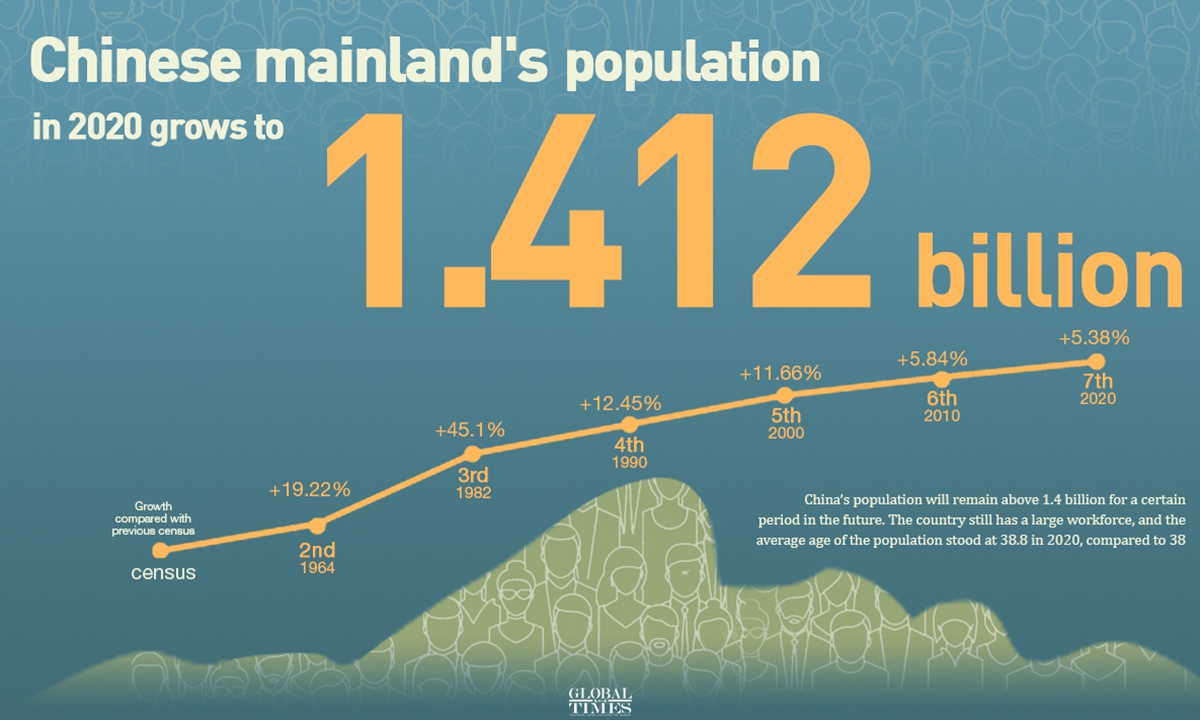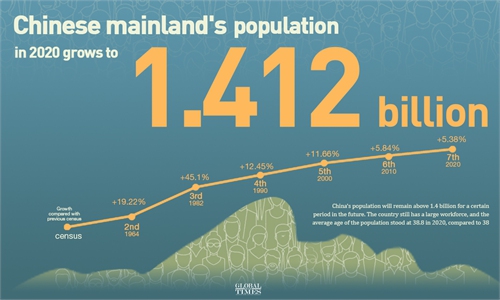Family planning policy urged to lift as China's population grows slower with low birth rate
Family planning policy urged to lift amid slower population growth

Photo: VCG
China's once-a-decade census results were released Tuesday, signaling a critical turning point as the country's population ages rapidly while the overall growth rate slows, bucking a five-decade trend. The data will serve as an important reference for adjustments to China's population and economic policy planning, which could see the lifting of the national family planning policy, Chinese demographers said on Tuesday.
With birth fertility rates expected to drop in the following years, demographers predict that India with its much higher fertility rate will overtake China as the world's most populous country by 2023 or 2024, earlier than the last UN prediction in 2019 that this would happen by 2027.
Over the past decade, China's population has continued to grow and China is still the most populous country in the world with steady improvement in population quality, and China's population will remain above 1.4 billion for a certain period in the future, Ning Jizhe, head of National Bureau of Statistics (NBS), said at Tuesday's media briefing. He said that China's population will peak in the future, although it is not certain when that peak will come.
The population of the Chinese mainland grew to 1.412 billion in 2020, up from 1.4 billion at the end of 2019, according to the results of the seventh population census, which was released by the NBS on Tuesday.
The figures show that China's population is growing more slowly than in the past. From 2010 to 2020, the Chinese mainland's population grew by 5.38 percent, but from 2000 to 2010, the Chinese mainland's population grew from 1.26 billion to 1.34 billion, an increase of 5.84 percent.
Although Ning did not give an exact time when China's population is expected to peak, Lu Jiehua, professor of sociology at Peking University, believes this may happen around 2027, before it starts to decline. Some demographers believe the peak may come as soon as 2022.
Despite China's population grows slower, its quality has significantly improved in the past decade. According to the census results, the average number of years of schooling for people aged 15 and over rose to 9.91 years from 9.08 years in 2010, and the gender ratio of the Chinese mainland's population reached 105.07 males to 100 females, slightly down from 105.2 in 2010. China's permanent urban population continues to increase, with the urban population on the mainland totaling 901.99 million, representing 63.89 percent of the total.
Meanwhile, the country's ethnic population increased steadily, fully reflecting the comprehensive development and progress of all ethnic groups in China under the leadership of the Communist Party of China (CPC), the NBS said.
The ethnic minority population in the Chinese mainland reached 125 million in 2020, accounting for 8.89 percent of the total population, up 0.4 percentage points compared with 2010.
The population undercount rate in the seventh population census was 0.05 percent, lower than international standards, and the seventh census' results were true and reliable, the NBS said.

Chinese mainland's population in 2020 grows to 1.412 billion. Graphic: GT
Lifting family planning
Chinese demographers who acknowledged China's population improvement in quality warned of worrying risks resulting from a rapid decline in the number of newborns and working-age population, while the country faces a growing aging population.
The number of people aged between 15 and 59 was 894 million, down by 6.79 percentage points from that in the 2010 census.
The number of people aged 60 and above grew to 264 million, up from 177.6 million in the 2010 census, and the number of people aged 65 and above grew to 190 million, up from 118.8 million in the 2010 census.
The population of people aged 14 and younger in the Chinese mainland was 253 million.
The results show that the number of seniors in the Chinese mainland for the first time exceeds the number of children in population census, according to the census data, meaning that the past decade has also seen the fastest growth in the number of seniors in China, said Du Peng, a professor at the School of Sociology and Population Studies at the Renmin University of China.
The senior population figures indicate that China will speed up new policymaking on retirement planning, demographers said.
China is eyeing a progressive, flexible and differentiated path to raising the retirement age. According to the Outline of the 14th Five-Year Plan (2021-2025) for National Economic and Social Development and the Long-Range Objectives Through the Year 2035, China will take small steps to raise the retirement age. It will also implement flexible, tailored policies for different groups, consider all factors and make overall plans.
China is also facing the risk of falling into the trap of low fertility, as it recorded 12 million births in 2020, marking a drop for the fourth consecutive year.
China's total fertility rate of women of childbearing age was 1.3, a relatively low level.
Liang Jianzhang, an economics professor at Peking University, told the Global Times that China's fertility rate will continue to drop in the coming years, and may become the world's lowest.
"According to the existing data, in the next 10 years, the number of women aged 22 to 35, which is the childbearing period, will drop by more than 30 percent compared with the present data. Without strong policy intervention, China's newborn population is likely to fall below 10 million in the next few years, and its fertility rate will be lower than Japan's, perhaps the lowest in the world," Liang predicted.
According to the World Bank, the birth rate of South Korea, Japan, US, and EU in 2018 was 0.98, 1.42, 1.73, and 1.6 respectively.
There were mounting calls to lift or even remove the family planning policy to cope with the declining birth rate on Tuesday.
He Yafu, an independent demographer, told the Global Times that there is no doubt that China will fully lift the family planning policy in the near future, and that China is likely to remove its family planning policy as early as this autumn during the sixth plenary session of the 19th Central Committee of the CPC.
China's population structure has been changing since the fifth population census in 2000, and the country needs comprehensive social policies to cope with the new population development paths, Lu said.
"Among those policies, further improving or lifting the family planning policy is at the top of the policy list," Lu said.
Removing the family planning policy will not be enough to avert a fall in China's total population, or prevent China from becoming another Japan, demographers said, noting that China should come up with more measures to encourage childbirth, such as subsidizing couples who choose to have more than one child.

Photo: GT
Succumbing to Japan, while overtaken by India?
Internationally, Japan is dubbed the "grayest nation," as nearly 30 percent of its people are over 65, and the country's overall population began to decline 10 years ago.
China's decline in births has come much later than Japan, and the aging problem is not as serious as Japan, although China's fertility rate is lower than Japan's, Chinese demographers said.
The median age of the population in Japan was 48.4 while it was 38.8 for China in 2020.
Chinese demographers had predicted the serious aging population scenario in China, and the issue is not out of control, Lu said, noting that compared with countries like Japan, China has "more room to maneuver" because of its large population base.
Unlike Japan where economic growth has hovered around 1 percent for years, in the next 20 to 30 years, China will still see a robust economic growth, which will be higher than the world average level, Huang Wenzheng, a demography expert and senior researcher from the Center for China and Globalization, told the Global Times.
If China removes the family planning policy and encourages births with strong incentive policies, learning from countries like Japan and South Korea, China may slow the decline of population and avoid the aging issue, Huang said.
Tomoo Marukawa, a professor at University of Tokyo, told the Global Times that Japan has made great efforts in reversing its population problem, such as establishing more kindergartens in big cities like Tokyo, and subsidizing couples who paid all by themselves for fertility treatment. He suggested that China should learn from Japan to build a long-term-care insurance system for the elderly, requiring adults aged 40 and above to pay insurance so that elderly people could be better taken care of.
He Yafu said that China's total fertility rate of 1.3 bears the effect of the second-child policy China introduced in 2016, and leaving out the effect, the total fertility rate would only be around 1.1.
India has maintained a fertility rate of around 2.3, which indicates that its population may surpass China's by 2023 or 2024, He said, earlier than the UN prediction in 2019 that this would happen by 2027. Some Chinese demographers also predicted that India may overtake China in population as early as 2022.
But China still has a large workforce and still enjoys a "demographic dividend," and with the continuous improvement of population quality it could greatly help make up for the shortage in population in the future, demographers said.



